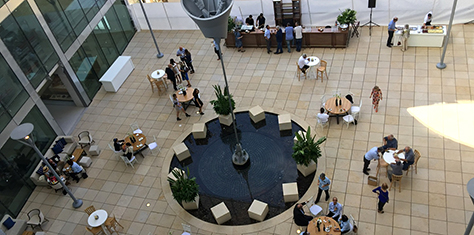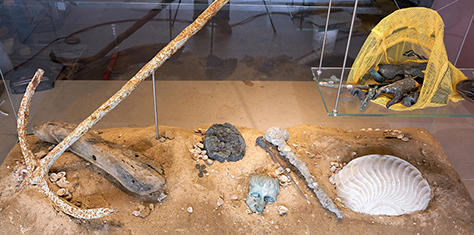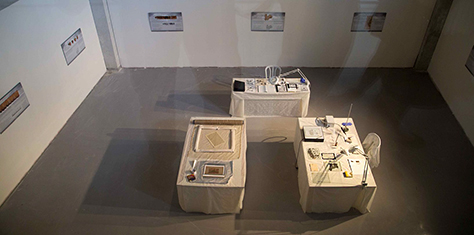No more waiting! Soon, you will be able get an unrivaled look at how millions of artifacts and treasures (never before seen by the public) at the Israel Antiquities Authority’s Jay and Jeanie Schottenstein National Campus for the Archaeology of Israel. The Museum is an open, interactive center for the collection, conservation, study, and presentation of roughly two million Holy Land antiquities.
The 36,000-square-meter complex that was designed by Israeli-born architect Moshe Safdie is expected to open within the year. The enormous complex sits on Museum Hill in Jerusalem, between the Israel Museum and the Bible Lands Museum. However, the National Campus is not a museum in the classic sense. “The IAA National Campus is a complex that highlights the wealth of the archaeological discoveries in Israel, but also brings to light the work behind some of the finds that you aren’t able to witness when you walk into a standard museum,” stated Jacob Fisch, executive director of the Friends of the Israel Antiquities Authority.

“Visitors will be able to take part in the fascinating process of archaeological conservation that, up until now, was carried out strictly behind the scenes,” said IAA Director Israel Hasson. A courtyard in the public wing of the complex enables visitors to sip coffee while watching conservationists cleaning Dead Sea Scrolls fragments or gluing ancient shards of pottery and glass back together. “Then, when you walk into the gallery, you will have a new perspective on what you’re seeing,” says Fisch. “Hopefully this will also create a passion for archaeology in the land of Israel. You’re not just going down a hall and seeing a beautiful piece, but the entire scope of archaeology and the work itself.”
Designed like a dig
Safdie designed the IAA National Campus like an archaeological excavation site, covered by a tensile transparent roof to evoke the canopies used to shade archaeological excavations. Faced with Jerusalem stone, the complex has three levels descending like the strata in a dig containing courtyards, galleries, climate-controlled storage, and footpaths overlooking labs and artifacts. The complex also houses the National Library for the Archaeology of Israel and the IAA’s offices.
Visitors will be able to walk on a suspended bridge while watching an audiovisual exhibit projected on thousands of artifacts. The eastern rooftop is dedicated to mosaics, many of which have never been displayed until now. A large nave of a Byzantine church with a colorful mosaic in it, excavated east of Ramle, was restored in its entirety in one of the open courtyards of the campus. The main entrance display cabinet is dedicated to the newest discoveries. The first exhibition in this cabinet presents bronze figurines unearthed last May from an ancient shipwreck near the Caesarea harbor. There will be an explanation of marine archaeology and the methods as to how the underwater artifacts were excavated.
Right on trend
Though the IAA’s concept for the campus has been developing for 12 years, Fisch says the fruition coincides with a strong global trend as museum-goers want to see conservation behind the scenes. This “desire” for behind-the-scenes experiences are also being accommodated at museums such as Musée d’Orsay in Paris, the Cincinnati Art Museum, and The Hermitage in St. Petersburg, among many others.
“We were one of the first in the world to focus on building a place that showcases the work itself in addition to the archaeology, and we are the first in Israel to combine objects and viewable conservation centers,” says Fisch.
Archaeology is of great interest around the world. The website of the Archaeology Institute of America gets more than 1.8 million unique visitors per month. Periodicals, such as Biblical Archaeology Review (with 115,000 subscribers), testify to the popularity of ancient finds. Coupling that interest to technology is a natural for Israelis, who live in a country with some of the oldest and most significant archaeological treasures. For example, Friends of the IAA developed the “Dig Quest: Israel” game app for children, available for both iOS and Android devices.
Dead Sea Scrolls
In keeping with another trend sweeping Israel’s museums (digital interactive technology), the center will offer multimedia options such as an activity where visitors puzzle together virtual pieces of Dead Sea Scrolls. The IAA houses roughly 15,000 Dead Sea Scrolls fragments, discovered in 11 Judean Desert caves between 1947 and 1956. Many of the 2,000-year-old fragments are digitized and available online, being displayed on a rotating basis at the Israel Museum’s Shrine of the Book. A number of the fragments are still being conserved.
“The conservation process will take place eventually in the complex, and the Bernard Osher Dead Sea Scrolls Gallery will focus on the conservation process in the past and future, and the digitization process,” says Fisch. “From there, visitors can cross the parking lot to see the scrolls in the Shrine of the Book.”
Originally posted at Israel21c.


